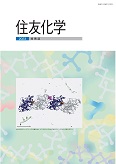FY 2023
2023.7.31 issue
-
Organic light-emitting diode (OLED) displays have been employed for several commercial applications, such as mobile phones, TVs, and so on, because of their high-speed response, thinness, and lightweight. Printable OLEDs have been given increasing attention owing to their large cost reduction potential, whereas most OLED displays are fabricated by vacuum evaporation using many vacuum chambers. At Sumitomo Chemical Co., Ltd., we have developed printable OLED materials and achieved their practical usage for the first time in the world. In this paper, we give a brief overview of existing printable OLEDs and present a feature of our materials and technologies.
(by Shohgo YAMAUCHI, Toshihiro HODAI)
-
To understand fluid dynamics, including multiphase flows, the equation with moving boundaries comprising the interfaces must be solved. This study introduces the volume of fluids (VOF) and level set (LS) methods. Consequently, the coupling techniques between the VOF and LS methods, and our proposed method are reviewed. The proposed method can reduce computational load and exhibits high accuracy. Finally, we demonstrate that the proposed method can visualize and contribute to the understanding of various flow phenomena.
(by Naoki SHIMADA, Yusuke UCHIHASHI, Yuta YAEGASHI)
-
Pyridachlometyl is a novel fungicide active ingredient that binds fungal tubulin and exhibits antifungal activity based on the modulation of fungal microtubule dynamics. Owing to a binding site that is distinct from that of the existing tubulin polymerization inhibitors, pyridachlometyl shows no cross-resistance to carbendazim and other fungicides (e.g.,DMI, QoI, and SDHI). Pyridachlometyl exhibits broad-spectrum antifungal activity, showing high efficacy against the sugar beet leaf spot, soybean purple stain, and powdery mildew, which affects various vegetable crops in field trials. In Japan, registration of ‘FUSEKI flowable’ as the first product of pyridachlometyl is expected by 2023.
(by Makoto KURAHASHI, Yuichi MATSUZAKI, Akio MANABE, Masato KAWAMURA, Fukumatsu IWAHASHI, Mitsuyoshi YAMANE, Ryoko MATSUYAMA, Yuko HANDA)
-
After the Plant Protection Product (PPP) Directive 91/414/EEC and the Biocidal Product (BP) Directive 98/8/EC were replaced by the PPP Regulation 1107/2009 and the BP Regulation 528/2012, respectively, an active substance (AS) having endocrine disrupting properties that may cause adverse effects in humans or in non-target organisms may not be approved in principle. However, new scientific criteria for the determination of endocrine disrupting properties of active substances were set out and applied in 2018. In this article, the data requirements on endocrine disrupting properties, the criteria set out temporarily, the specific scientific criteria laid down, and the assessment procedure after the introduction of new scientific criteria, etc. are summarised.
(by Hiroko HARADA, Mio TATSU, Keiko YAMANE, Setsuko YABUSHITA, Hidenori MATSUSHITA, Rika KODAKA, Mika OTA)
